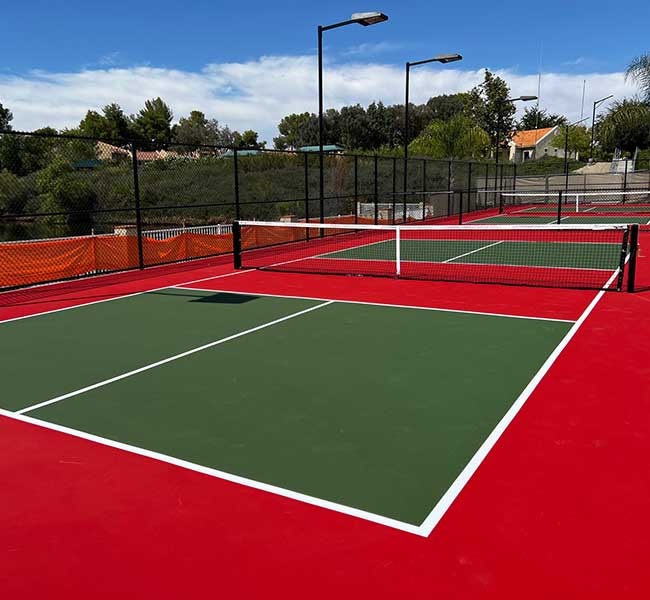Custom-made Pickleball Court Construction for Residential and Commercial Spaces
Custom-made Pickleball Court Construction for Residential and Commercial Spaces
Blog Article
Sustainable Practices in Pickleball Court Building And Construction You Must Know
As the popularity of pickleball continues to climb, so also does the demand for lasting methods in court building and construction. The impact of these practices expands much beyond the court itself.
Selecting Eco-Friendly Materials
Choosing green materials is a crucial action in the building of sustainable pickleball courts. The choice of lasting products not just reduces ecological effect but additionally enhances the long life and performance of the court. Key materials include recycled rubber for the surface area, which offers excellent toughness and shock absorption while drawing away waste from land fills.
In addition, utilizing in your area sourced products reduces transport discharges and sustains local economies. Pickleball court construction. Utilizing native woods for secure fencing and seats can give a sustainable visual while ensuring durability against the components.
Incorporating permeable materials for court foundations can further contribute to sustainability by enabling all-natural water drainage and minimizing drainage. These selections not only shield neighborhood ecological communities yet additionally promote healthier play atmospheres.
Efficient Water Drainage Solutions
While the option of environment-friendly products is essential, implementing effective drain services is equally essential for keeping lasting pickleball courts. Correct drain not just secures the court surface from water damage but additionally decreases erosion and drainage, promoting ecological integrity.
Effective drainage systems can consist of absorptive paving, which allows water to infiltrate the ground rather than pooling on the surface area. This reduces the likelihood of standing water, which can result in mold and other maintenance problems. Additionally, incorporating strategically placed drain channels and swales can route excess water far from the court area, ensuring a dry having fun surface and protecting against dirt disintegration.
Using indigenous greenery in the landscape design around the courts can even more boost drainage by soaking up excess water and minimizing overflow. These plants require less irrigation and promote biodiversity, lining up with lasting practices.
In addition, it is crucial to on a regular basis keep the drain system to guarantee its lasting efficiency. This consists of clearing debris and monitoring for obstructions. By prioritizing reliable water drainage services, pickleball court manufacturers can substantially add to the sustainability and long life of the center, inevitably benefiting both gamers and the environment.
Energy-Efficient Illumination Options
As the need for pickleball remains to expand, incorporating energy-efficient lights alternatives into court design has actually come to be increasingly vital for sustainability. Conventional lights systems often consume excessive power, adding to higher functional expenses and environmental influence. Embracing modern-day, energy-efficient innovations is vital for both new building and constructions and remodellings.
LED (Light Emitting Diode) lighting stands apart as a premier option as a result of its durability and power cost savings (Pickleball court construction). Contrasted to conventional lights, LEDs utilize around 75% much less energy and can last up to 25 times much longer, significantly minimizing maintenance prices. Furthermore, the directional nature of LED lighting decreases light contamination, making certain that lighting is concentrated on the court as opposed to surrounding areas.

Sustainable Surface Alternatives
Checking out sustainable surface options for pickleball courts has acquired grip amongst gamers and builders alike. The focus on environmentally friendly products not just lines up with the expanding environmental recognition however also boosts the performance and longevity of the courts.
This product provides superb shock absorption, decreasing the threat of injuries for players while promoting sustainability. These tiles are simple to install and replace, and their versatility permits for different court arrangements.
Natural grass courts are also becoming a sustainable selection, advertising biodiversity and lowering the warm island result. Nonetheless, they require routine maintenance and water, which may not align with all sustainability goals.

Water Preservation Strategies

An additional reliable strategy entails the installment of rain harvesting systems. These systems keep and collect rainwater for use in keeping court surfaces and landscaping. This method not only saves safe and clean water yet also decreases dependence on metropolitan resources.
Moreover, using drought-resistant landscape design around the courts is crucial. Native plants call for less water and are better adapted to neighborhood environment conditions, thus lowering total water consumption. Additionally, utilizing efficient irrigation systems, such as drip irrigation, guarantees that water is site here provided straight to plant origins, lessening dissipation and waste.
Verdict
Integrating sustainable methods in pickleball court building and construction considerably adds to ecological preservation and resource efficiency. By focusing on these techniques, the construction of pickleball courts can align with more comprehensive ecological goals why not try here while advertising longevity and performance within neighborhoods.
As the appeal of pickleball proceeds to rise, so too does the requirement for lasting techniques in court construction.Selecting green materials is a critical action in the construction of sustainable pickleball courts. By prioritizing energy-efficient lighting options, pickleball court producers can add to a much more lasting future while satisfying the requirements of stakeholders and players alike.Incorporating lasting surface area choices not just improves the performance of pickleball courts but also leads the means for applying effective water preservation techniques.Incorporating lasting techniques in pickleball court building substantially contributes to environmental conservation and resource performance.
Report this page